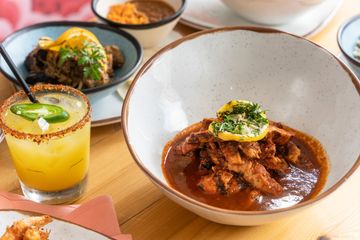Make your evenings memorable with happy hour and savor classic Mexican drinks
Why Mexican Food Is Famous: Checking Out the Cultural Value Behind the Dishes
Mexican food sticks out for its vibrant flavors and deep cultural roots. The fusion of spanish and aboriginal influences produces an unique cooking identity. Each meal informs a story of neighborhood, practice, and event. Components like corn and chili peppers play necessary roles in forming these narratives. To understand the complete value of these cooking practices, one should check out the layers of history and significance that enrich every bite. What lies under the surface area of this beloved cuisine?
The Historic Roots of Mexican Food
Mexican food is typically celebrated for its varied active ingredients and lively flavors, its historic origins run deep, reflecting a rich tapestry of social impacts. Stemming from ancient Mesoamerican civilizations, such as the Aztecs and Mayans, Mexican food progressed with centuries of farming practices that incorporated local crops like maize, beans, and chili peppers. The arrival of Spanish colonizers in the 16th century presented brand-new ingredients, consisting of pork, milk, and rice, which fused with native customs to produce special cooking fusions. This mix of influences not just shaped the meals however likewise stood for the social and cultural characteristics of the moment. Throughout the years, regional variations arised, influenced by location, environment, and local personalizeds. As a result, Mexican cuisine stands as a reflection of its historical trip, embodying the strength and versatility of its individuals while commemorating their heritage through food.
Regional Diversity and Its Effect On Flavors
Regional diversity plays an essential role in shaping the flavors of Mexican food, with each area adding one-of-a-kind active ingredients based on local agriculture and tradition. Standard food preparation methods additionally improve these flavors, reflecting the personalizeds and backgrounds of individuals. In addition, the differing climates across Mexico influence which ingredients prosper, causing distinctive regional meals that commemorate the nation's cooking splendor.
Special Ingredients by Region
Mexican food showcases a remarkable variety of unique ingredients that vary substantially throughout its diverse regions, each contributing cooking techniques and unique tastes. In the coastal areas, fish and shellfish such as shrimp and fish are staples, typically paired with tropical fruits like mango and coconut. The central highlands are recognized for their abundant variety of beans, corn, and squash, forming the basis of several conventional recipes. In the Yucatán Peninsula, achiote and sour oranges convey an unique taste profile, while the northern areas favor beef and wheat-based dishes, mirroring the impact of surrounding cultures. Each area's climate and geography form the neighborhood components, creating a vivid tapestry of flavors that highlight Mexico's rich cooking heritage.

Standard Food Preparation Techniques
The varied components located throughout Mexico not just shape the meals but additionally influence the conventional food preparation strategies utilized in each area. As an example, in Oaxaca, the use of a stone mortar and pestle, called a "metate," is widespread for grinding corn and seasonings to create masa and mole. On the other hand, coastal regions usually use cooking and steaming methods to prepare fish and shellfish, reflecting their accessibility to fresh catch. The highlands might highlight slow-cooking techniques, such as barbacoa, where meats are covered in maguey leaves and hidden in the ground. Each strategy is deeply rooted in the local culture, showcasing the significance of tradition while enhancing the distinctive flavors that identify Mexican food throughout diverse landscapes.
Climate's Flavor Impact
Environment differs considerably throughout Mexico, it plays an essential duty in shaping the tastes and active ingredients that specify the country's cuisine. Various regions experience unique climate patterns, influencing the agricultural result and cooking methods. The dry north is recognized for its hearty meats, while the rich south deals a wealth of exotic fruits and vegetables. Coastal areas benefit from fresh fish and shellfish, which ends up being a staple in their meals. Additionally, the highlands create unique natural herbs and seasonings that add to regional specializeds. This climatic variety not only enriches the taste profiles of Mexican food however additionally shows the cultural identification of each region, showcasing the deep link between the environment and culinary heritage.
The Role of Active Ingredients in Culinary Identity
Vital to understanding cooking identification, the components of a food expose deep historic stories and social links. In Mexican cuisine, staples such as corn, beans, and chili peppers offer not just as fundamental elements however also as signs of strength and adjustment. Corn, for circumstances, is sacred, showing its value to farming techniques and indigenous cultures. The selection of beans showcases the nation's biodiversity, while chili peppers add deepness and warm, representing regional variants and culinary creative thinking.
These components are intertwined with rituals, traditions, and neighborhood personalizeds, highlighting the significance of area in forming culinary identification. The assimilation of herbs like cilantro and spices such as cumin additional enriches the flavor account, demonstrating the influence of both aboriginal practices and colonial histories. Collectively, these components develop a vibrant tapestry that shows the intricacies of Mexican culture, making its cuisine a powerful expression of identity and heritage.
Conventional Cooking Methods and Their Importance
Conventional food preparation techniques in Mexican food work as an important web link to the nation's heritage, preserving ancient methods gave via generations. These methods not only reflect local diversity yet additionally enhance the one-of-a-kind tastes that define the cuisine. Recognizing their relevance exposes the social richness installed in every meal.
Old Techniques Maintaining Heritage
While contemporary cooking techniques have changed the landscape of Mexican cuisine, ancient methods remain a crucial web link to the country's abundant heritage. Methods such as nixtamalization, the process of dealing with corn with lime to enhance its dietary value, these details have been critical fit traditional meals. The usage of clay pots and rock mortars, recognized as molcajetes, likewise mirrors the focus on credibility and taste that has been passed down with generations. These approaches not only maintain the stability of components yet likewise embody common values and cultural practices. By remaining to utilize these ancient strategies, contemporary Mexican cooks preserve a connection to their ancestors, making certain that the cookeries stay reflective and lively of the country's diverse background.
Regional Techniques and Flavors
As diverse as its landscapes, Mexican cuisine is characterized by a myriad of local strategies and tastes that reflect the special cultural influences and local components of each location. In Oaxaca, the usage of the comal for cooking tortillas demonstrates a custom gave with generations, while the Yucatán area showcases the slow-cooking approach recognized as cochinita pibil, stressing marinated pork covered in banana leaves. Coastal areas highlight seafood preparations, with techniques like ceviche reflecting indigenous and Spanish impacts. Each region's distinct flavors, such as the great smoky chipotle from Veracruz or the vivid chilies from Puebla, contribute to a rich tapestry of flavors - happy hour. These traditional techniques not only boost culinary variety yet likewise work as a representation of the durability and creativity of Mexican culture
Festivities and celebrations: Food as a Social Expression
Events and festivities in Mexico are typically noted by a variety of lively meals that reflect the nation's abundant cultural heritage. Conventional meals, such as tamales during Día de los Muertos and pozole during Independence Day, showcase cooking methods and regional active ingredients, symbolizing community and familial bonds. Food comes to be a tool for narration, with each recipe carrying historical importance and regional identities.
Along with the dishes themselves, the routines surrounding cooking and consumption play a necessary role in these celebrations. Households gather to develop intricate dishes, cultivating connections and preserving traditions passed down via generations. The common nature of these cooking techniques highlights hot pot near me the importance of sharing food as an expression of love and unity. Via these festive events, Mexican food goes beyond mere sustenance, offering as a social emblem that commemorates heritage, spirituality, and the joy of togetherness.
International Influence and Recognition of Mexican Gastronomy
Just how has Mexican gastronomy gained such widespread honor around the globe? The answer exists in its vibrant tastes, diverse components, and abundant cultural heritage that reverberate worldwide. Acknowledged by UNESCO as an Abstract Cultural Heritage of Humankind, Mexican cuisine showcases a distinct blend of native and Spanish influences, making wikipedia reference it distinctive and attractive.
Dining establishments concentrating on Mexican recipes have actually proliferated internationally, presenting genuine tastes such as mole, tacos, and tamales to diverse tastes. The appeal of Mexican food has also been bolstered by celebrity chefs and cooking programs, which highlight its cooking techniques and practices.
Food festivals and social events commemorate Mexican gastronomy, further elevating its standing on the world stage. Therefore, Mexican cuisine transcends boundaries, cultivating gratitude for its historic importance and cooking virtuosity, guaranteeing its long-lasting impact in the international cooking landscape.
Regularly Asked Inquiries
What Are the Health Benefits of Conventional Mexican Dishes?
Conventional Mexican meals use countless wellness advantages, consisting of high fiber content from veggies and beans, healthy and balanced fats from avocados, and essential nutrients from flavors. These ingredients contribute to boosted food digestion, heart wellness, and general wellness.

Exactly How Can I Recreate Authentic Mexican Recipes at Home?
To recreate genuine Mexican recipes at home, one must source fresh active ingredients, use conventional food preparation methods, explore local variations, and adhere to trusted dishes while embracing the lively tastes and cultural nuances inherent in Mexican food. (hand crafted margarita)
What Duty Do Spices Play in Mexican Food Preparation?
Seasonings are crucial in Mexican cooking, improving tastes and scents. They offer depth and intricacy to meals, showing regional diversity. Typical spices like chili, cumin, and oregano add to the lively, vibrant profiles particular of Mexican cuisine.
Exist Vegetarian or Vegan Options in Mexican Cuisine?
Yes, Mexican food provides countless vegetarian and vegan alternatives. Dishes such as chiles rellenos, nopales, and numerous bean preparations showcase the rich tastes and active ingredients available, making it easily accessible for those adhering to plant-based diets.
Exactly How Has Mexican Food Influenced Various Other Global Cuisines?
Mexican cuisine has actually greatly influenced international foods through the intro of components like corn, beans, and chili peppers, motivating blend dishes and improving flavor accounts in numerous cooking customs, especially in the United States and Latin America.
Mexican food stands out for its lively flavors and deep social roots. Mexican cuisine is often celebrated for its diverse components and vibrant flavors, its historical roots run deep, showing a rich tapestry of social impacts. Regional variety plays a necessary duty in forming the flavors of Mexican cuisine, with each area adding one-of-a-kind components based on regional agriculture and tradition. Mexican food showcases an amazing array of unique components that vary considerably across its diverse areas, each contributing culinary methods and unique tastes. As diverse as its landscapes, Mexican cuisine is characterized by a myriad of local strategies and tastes that reflect the unique cultural influences and neighborhood components of each area.